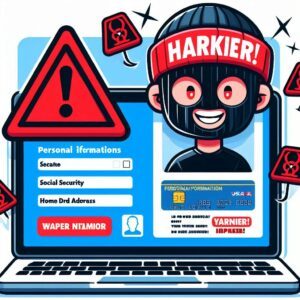Phishing is a cyberattack where attackers use deceptive communications to trick individuals into revealing sensitive information. These deceptive communications are usually emails that seem to come from reputable sources, like banks or other trusted organizations. The goal is to get you to click on a malicious link, download an attachment, or provide personal details such as passwords and credit card numbers.
Phishing is so common in fact, in a recent survey, 92% of businesses said that they had been a victim of phishing.(CompTIA)
Table of Contents
- Types of Phishing Attacks
- 10 Strategies to Protect Yourself from Phishing
- Reporting and Recovering from Phishing Attempts
The word “phishing” itself is a play on the word “fishing,” where the attacker is fishing for your personal information. It began in the 1990s and has evolved significantly, becoming more sophisticated over the years. Attackers now use advanced techniques to make their communications appear legitimate and trustworthy.
in 2020, there were 241,324 reported phishing attacks. (ProofPoint)Those are just the ones that were reported. No doubt there were a ton more phishing attempts. Phishing attacks are still growing. In 2022 there was a 61% rise in phishing attacks compared to 2021.(Cisco)
Phishing attacks come in various forms, each with its unique approach to deceive the target. Some common types include email phishing, spear phishing, whaling, and malware phishing. Email phishing is the most common type, where generic malicious emails are sent to a wide audience. Spear phishing is more targeted, focusing on specific individuals with personalized content. Whaling takes this a step further by targeting high-profile individuals like CEOs. Malware phishing involves using attachments or links that download harmful software onto the victim’s system.
The impact of phishing can be severe, leading to identity theft, financial losses, and large-scale data breaches. For instance, providing your login credentials to a phishing site can result in unauthorized access to your bank accounts, email, or other sensitive systems. It’s not just about the immediate financial loss; theft of sensitive data can have long-term repercussions, affecting your personal and professional life.
Types of Phishing Attacks

Phishing isn’t a one-size-fits-all scenario. Attackers use various methods tailored to target different victims and achieve different objectives. Here are 4 of the most common types of phishing attacks you need to be aware of:
- Email Phishing:
This is the most widespread method. Attackers send generic, malicious emails to a broad audience. These emails often contain deceptive links or attachments, urging you to click or download something. They might present an urgent fake scenario, like a warning from your bank, to pressure you into taking quick action. - Spear Phishing:
Unlike email phishing, spear phishing is targeted. Attackers customize their messages for specific individuals or organizations. They might use information they’ve gathered about you from social media or other sources to craft a more believable message. Since these emails are personalized, they can be much harder to identify as malicious. - Whaling:
This type targets high-profile individuals within an organization, such as executives or CEOs. The stakes are higher, and the attackers spend more time researching their targets. These emails often appear to come from senior management or a trusted business partner, making them tricky to spot. - Malware Phishing:
In this scenario, attackers send emails containing links or attachments that, when clicked or opened, install malware on your device. This malware can steal sensitive information, monitor your activities, or even ransom your data.
Understanding these different tactics can make it easier to recognize and avoid phishing attempts. The more familiar you are with these methods, the better prepared you’ll be to protect yourself and your sensitive information.
10 Strategies to Protect Yourself from Phishing

- E-mail Caution:
Avoid clicking on links or downloading attachments from unknown or unexpected emails. Always make sure to verify the sender’s identity before taking any action. If something feels off, trust your gut and double-check. - URLs can be tricky:
Phishing sites often mimic legitimate ones but with small changes in the web address. Always take a moment to inspect the URL before entering any of your personal information. Look for subtle differences and ensure the site uses HTTPS. - Use Multi-Factor Authentication:
(MFA) adds an extra layer of security. Even if your credentials get compromised, the attacker would also need the second form of verification. Enable MFA on all your important accounts to significantly reduce the risk. - Keep everything updated:
Regular updates to your operating system, browsers, and software protect against vulnerabilities that phishing attacks might exploit. Set your devices to update automatically and check regularly for software updates. - Stay informed on phishing tactics:
Make an effort to educate yourself and those around you. Share information with your family, friends, and colleagues to create a well-informed community. - Verify requests for sensitive information:
Legitimate organizations rarely ask for sensitive details via email. If in doubt, contact the organization directly through official channels to confirm the request’s legitimacy. Better safe than sorry. - Anti-phishing tools:
Browser extensions or security software can identify and block phishing attempts before they reach you. Make use of these tools to add an extra layer of protection. - Caution with pop-ups:
Avoid entering personal information into pop-up screens, especially if they ask for sensitive data. Close them immediately and navigate to the site directly through your browser to ensure its legitimacy. - Monitor your accounts:
Regularly checking your bank, credit card, and other sensitive accounts can help you spot and address suspicious activity quickly. - Reporting phishing attempts:
If you receive a suspicious email, report it to your IT department or the company being spoofed. This not only protects you but also helps prevent others from falling victim.
Reporting and Recovering from Phishing Attempts

Reporting phishing attempts is a crucial step in combating these attacks. Notify your IT department or the organization directly if you receive a suspicious email or encounter a fraudulent website. This collective effort aids in preventing others from being targeted by the same attack. Many organizations have dedicated email addresses or online forms for reporting such incidents.
If you fall victim to a phishing attack, taking immediate action can mitigate damage. Start by changing your passwords on any compromised accounts and enable multi-factor authentication if you haven’t already. Notify your financial institutions if your banking details were involved, and monitor your accounts for any unauthorized transactions. It’s also wise to run a full security scan on your devices to detect and remove any lurking malware.
Resources and support are available for phishing victims. Many organizations offer guides and hotlines to help you navigate recovery steps. The Federal Trade Commission (FTC) provides comprehensive advice on what to do if your identity is stolen, including placing fraud alerts and freezing your credit. Utilize these resources to regain control and protect your information.
Preventative measures are essential to avoid future phishing attempts. Reflect on how the attack occurred and apply new security practices to prevent recurrence. Regularly update passwords, use MFA, and stay informed about the latest phishing methods. Educating yourself and others on recognizing phishing attempts creates a stronger defense against future attacks.

Thanks for such a helpful article. Phishing is such a sneaky and common cyber threat these days. It’s wild how easily attackers can make emails look legitimate, tricking people into giving away their personal info. Being aware of different phishing tactics and taking simple steps like using multi-factor authentication and double-checking URLs can really make a difference in staying safe. I am continuously getting these kind of emails.
I’m glad you found it helpful. Sorry to hear you get so many of those e-mails.